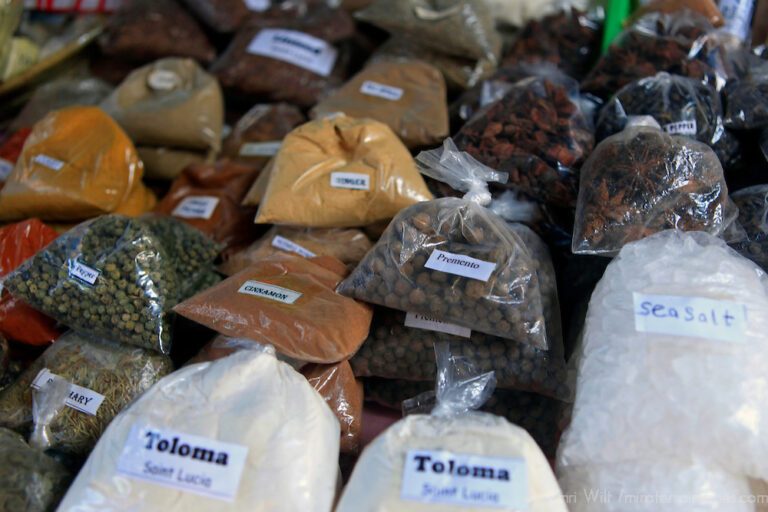Introduction: Saint Lucian cuisine and its spice culture
Saint Lucian cuisine is a fusion of African, European, and East Indian flavors. It is known for its rich and spicy taste, which is attributed to the variety of spices and herbs used in its preparation. These spices and herbs are essential ingredients in Saint Lucian cooking, and they are used to enhance the aroma, taste, and texture of the dishes.
Saint Lucian cuisine is a reflection of the island’s history and cultural diversity. The use of spices and herbs is an important aspect of this culture, and it is an art that has been passed down from generation to generation. Spices and herbs are used in different ways, and they serve different purposes in Saint Lucian cooking. In this article, we will explore some of the most common spices and herbs used in Saint Lucian cuisine.
Bay leaves: The fragrant and versatile spice in Saint Lucian cooking
Bay leaves are a fragrant spice that is used in Saint Lucian cooking to add flavor and aroma to dishes. These leaves are usually dried and added to stews, soups, and sauces to enhance the taste. Bay leaves are versatile, and they can be used in both sweet and savory dishes. They are also used in marinades for meat and fish.
Bay leaves are known for their health benefits. They are rich in vitamin A, vitamin C, iron, and calcium. They also have anti-inflammatory properties that help to reduce pain and swelling. In Saint Lucian cooking, bay leaves are an essential ingredient, and they are used to add depth and complexity to dishes.
Thyme: The herb that adds depth and flavor to Saint Lucian dishes
Thyme is a herb that is used in Saint Lucian cooking to add depth and flavor to dishes. It is a fragrant herb that is used in marinades, stews, soups, and sauces. Thyme is also used in meat rubs and in seasoning fish. It is an essential ingredient in many traditional Saint Lucian dishes.
Thyme is known for its health benefits. It is rich in vitamins and minerals, and it has anti-inflammatory properties that help to reduce pain and swelling. Thyme is also used to relieve coughs and colds. In Saint Lucian cooking, thyme is an important herb that is used to enhance the aroma and flavor of dishes.
Nutmeg: The quintessential spice in Saint Lucian sweet and savory dishes
Nutmeg is a quintessential spice in Saint Lucian cooking. It is used in both sweet and savory dishes, and it adds a warm and nutty flavor to dishes. Nutmeg is used in stews, soups, and sauces. It is also used in baked goods such as cakes, pies, and bread.
Nutmeg is known for its health benefits. It is rich in antioxidants, and it has anti-inflammatory properties that help to reduce pain and swelling. Nutmeg is also used to relieve indigestion and improve digestion. In Saint Lucian cooking, nutmeg is an essential spice that is used to add flavor and aroma to dishes.
Cloves: The spice that gives Saint Lucian dishes a warm, sweet flavor
Cloves are a spice that is used in Saint Lucian cooking to add a warm and sweet flavor to dishes. They are used in stews, soups, and sauces. Cloves are also used in baked goods such as cakes and cookies. They are an essential ingredient in many traditional Saint Lucian dishes.
Cloves are known for their health benefits. They are rich in antioxidants, and they have anti-inflammatory properties that help to reduce pain and swelling. Cloves are also used to relieve toothaches and improve digestion. In Saint Lucian cooking, cloves are an important spice that is used to add flavor and aroma to dishes.
Ginger: The root spice that adds a zing of flavor to Saint Lucian cuisine
Ginger is a root spice that is used in Saint Lucian cooking to add a zing of flavor to dishes. It is used in marinades, stews, soups, and sauces. Ginger is also used in baked goods such as cakes and cookies. It is an essential ingredient in many traditional Saint Lucian dishes.
Ginger is known for its health benefits. It is rich in antioxidants, and it has anti-inflammatory properties that help to reduce pain and swelling. Ginger is also used to relieve nausea and improve digestion. In Saint Lucian cooking, ginger is an important spice that is used to add flavor and aroma to dishes. It is also used for its medicinal properties.

